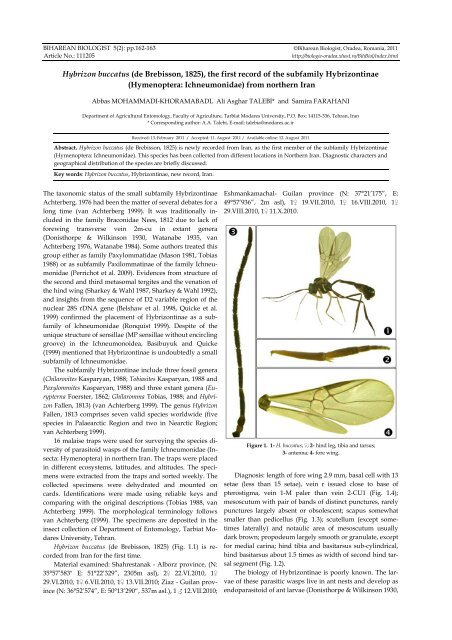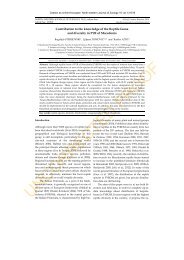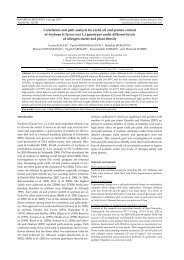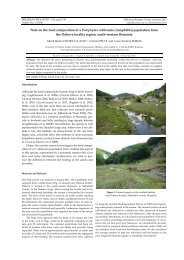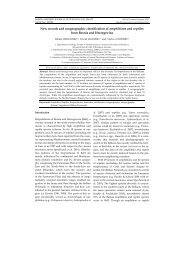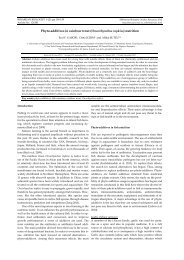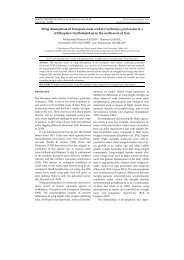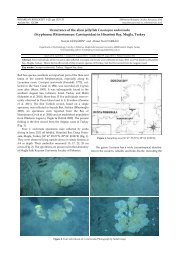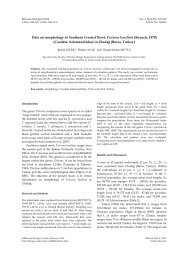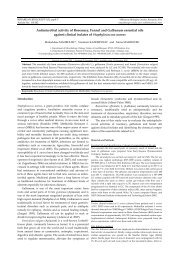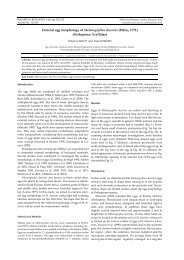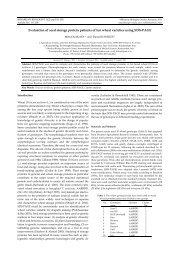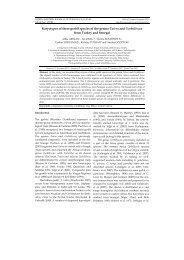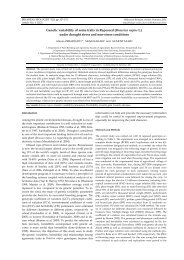(de Brebisson, 1825), the first record of the subfamily Hybrizontinae
(de Brebisson, 1825), the first record of the subfamily Hybrizontinae
(de Brebisson, 1825), the first record of the subfamily Hybrizontinae
Create successful ePaper yourself
Turn your PDF publications into a flip-book with our unique Google optimized e-Paper software.
BIHAREAN BIOLOGIST 5(2): pp.162-163 ©Biharean Biologist, Ora<strong>de</strong>a, Romania, 2011<br />
Article No.: 111205 http://biologie-ora<strong>de</strong>a.xhost.ro/BihBiol/in<strong>de</strong>x.html<br />
Hybrizon buccatus (<strong>de</strong> <strong>Brebisson</strong>, <strong>1825</strong>), <strong>the</strong> <strong>first</strong> <strong>record</strong> <strong>of</strong> <strong>the</strong> <strong>subfamily</strong> <strong>Hybrizontinae</strong><br />
(Hymenoptera: Ichneumonidae) from nor<strong>the</strong>rn Iran<br />
Abbas MOHAMMADI-KHORAMABADI, Ali Asghar TALEBI* and Samira FARAHANI<br />
Department <strong>of</strong> Agricultural Entomology, Faculty <strong>of</strong> Agriculture, Tarbiat Modares University, P.O. Box: 14115-336, Tehran, Iran<br />
* Corresponding author: A.A. Talebi, E-mail: talebia@modares.ac.ir<br />
Received: 13. February 2011 / Accepted: 11. August 2011 / Available online: 12. August 2011<br />
Abstract. Hybrizon buccatus (<strong>de</strong> <strong>Brebisson</strong>, <strong>1825</strong>) is newly recor<strong>de</strong>d from Iran, as <strong>the</strong> <strong>first</strong> member <strong>of</strong> <strong>the</strong> <strong>subfamily</strong> <strong>Hybrizontinae</strong><br />
(Hymenoptera: Ichneumonidae). This species has been collected from different locations in Nor<strong>the</strong>rn Iran. Diagnostic characters and<br />
geographical distribution <strong>of</strong> <strong>the</strong> species are briefly discussed.<br />
Key words: Hybrizon buccatus, <strong>Hybrizontinae</strong>, new <strong>record</strong>, Iran.<br />
The taxonomic status <strong>of</strong> <strong>the</strong> small <strong>subfamily</strong> <strong>Hybrizontinae</strong><br />
Achterberg, 1976 had been <strong>the</strong> matter <strong>of</strong> several <strong>de</strong>bates for a<br />
long time (van Achterberg 1999). It was traditionally inclu<strong>de</strong>d<br />
in <strong>the</strong> family Braconidae Nees, 1812 due to lack <strong>of</strong><br />
forewing transverse vein 2m-cu in extant genera<br />
(Donisthorpe & Wilkinson 1930, Watanabe 1935, van<br />
Achterberg 1976, Watanabe 1984). Some authors treated this<br />
group ei<strong>the</strong>r as family Paxylommatidae (Mason 1981, Tobias<br />
1988) or as <strong>subfamily</strong> Paxilommatinae <strong>of</strong> <strong>the</strong> family Ichneumonidae<br />
(Perrichot et al. 2009). Evi<strong>de</strong>nces from structure <strong>of</strong><br />
<strong>the</strong> second and third metasomal tergites and <strong>the</strong> venation <strong>of</strong><br />
<strong>the</strong> hind wing (Sharkey & Wahl 1987, Sharkey & Wahl 1992),<br />
and insights from <strong>the</strong> sequence <strong>of</strong> D2 variable region <strong>of</strong> <strong>the</strong><br />
nuclear 28S rDNA gene (Belshaw et al. 1998, Quicke et al.<br />
1999) confirmed <strong>the</strong> placement <strong>of</strong> <strong>Hybrizontinae</strong> as a <strong>subfamily</strong><br />
<strong>of</strong> Ichneumonidae (Ronquist 1999). Despite <strong>of</strong> <strong>the</strong><br />
unique structure <strong>of</strong> sensillae (MP sensillae without encircling<br />
groove) in <strong>the</strong> Ichneumonoi<strong>de</strong>a, Basibuyuk and Quicke<br />
(1999) mentioned that <strong>Hybrizontinae</strong> is undoubtedly a small<br />
<strong>subfamily</strong> <strong>of</strong> Ichneumonidae.<br />
The <strong>subfamily</strong> <strong>Hybrizontinae</strong> inclu<strong>de</strong> three fossil genera<br />
(Chilarovites Kasparyan, 1988; Tobiasites Kasparyan, 1988 and<br />
Paxylommites Kasparyan, 1988) and three extant genera (Eurypterna<br />
Foerster, 1862; Ghilaromma Tobias, 1988; and Hybrizon<br />
Fallen, 1813) (van Achterberg 1999). The genus Hybrizon<br />
Fallen, 1813 comprises seven valid species worldwi<strong>de</strong> (five<br />
species in Palaearctic Region and two in Nearctic Region;<br />
van Achterberg 1999).<br />
16 malaise traps were used for surveying <strong>the</strong> species diversity<br />
<strong>of</strong> parasitoid wasps <strong>of</strong> <strong>the</strong> family Ichneumonidae (Insecta:<br />
Hymenoptera) in nor<strong>the</strong>rn Iran. The traps were placed<br />
in different ecosystems, latitu<strong>de</strong>s, and altitu<strong>de</strong>s. The specimens<br />
were extracted from <strong>the</strong> traps and sorted weekly. The<br />
collected specimens were <strong>de</strong>hydrated and mounted on<br />
cards. I<strong>de</strong>ntifications were ma<strong>de</strong> using reliable keys and<br />
comparing with <strong>the</strong> original <strong>de</strong>scriptions (Tobias 1988, van<br />
Achterberg 1999). The morphological terminology follows<br />
van Achterberg (1999). The specimens are <strong>de</strong>posited in <strong>the</strong><br />
insect collection <strong>of</strong> Department <strong>of</strong> Entomology, Tarbiat Modares<br />
University, Tehran.<br />
Hybrizon buccatus (<strong>de</strong> <strong>Brebisson</strong>, <strong>1825</strong>) (Fig. 1.1) is recor<strong>de</strong>d<br />
from Iran for <strong>the</strong> <strong>first</strong> time.<br />
Material examined: Shahrestanak - Alborz province, (N:<br />
35°57’583" E: 51°22’329”, 2305m asl), 2♀ 22.VI.2010, 1♀<br />
29.VI.2010, 1♀ 6.VII.2010, 1♀ 13.VII.2010; Ziaz - Guilan province<br />
(N: 36°52’574”, E: 50°13’290“, 537m asl.), 1 ♂ 12.VII.2010;<br />
Eshmankamachal- Guilan province (N: 37°21’175”, E:<br />
49°57’936”, 2m asl), 1♀ 19.VII.2010, 1♀ 16.VIII.2010, 1♀<br />
29.VIII.2010, 1♀ 11.X.2010.<br />
Figure 1. 1- H. buccatus, ♀; 2- hind leg, tibia and tarsus;<br />
3- antenna; 4- fore wing.<br />
Diagnosis: length <strong>of</strong> fore wing 2.9 mm, basal cell with 13<br />
setae (less than 15 setae), vein r issued close to base <strong>of</strong><br />
pterostigma, vein 1-M paler than vein 2-CU1 (Fig. 1.4);<br />
mesoscutum with pair <strong>of</strong> bands <strong>of</strong> distinct punctures, rarely<br />
punctures largely absent or obsolescent; scapus somewhat<br />
smaller than pedicellus (Fig. 1.3); scutellum (except sometimes<br />
laterally) and notaulic area <strong>of</strong> mesoscutum usually<br />
dark brown; propo<strong>de</strong>um largely smooth or granulate, except<br />
for medial carina; hind tibia and basitarsus sub-cylindrical,<br />
hind basitarsus about 1.5 times as width <strong>of</strong> second hind tarsal<br />
segment (Fig. 1.2).<br />
The biology <strong>of</strong> <strong>Hybrizontinae</strong> is poorly known. The larvae<br />
<strong>of</strong> <strong>the</strong>se parasitic wasps live in ant nests and <strong>de</strong>velop as<br />
endoparasitoid <strong>of</strong> ant larvae (Donisthorpe & Wilkinson 1930,
First <strong>record</strong> <strong>of</strong> Hybrizon buccatus from Iran<br />
Watanabe 1935, 1984, Feener 2000). The host-parasitoid relationship<br />
between Lasius alienus (Foerster 1850) and Paxylomma<br />
buccata was <strong>de</strong>tected for <strong>the</strong> fist time by Donisthorpe<br />
& Wilkinson (1930).<br />
H. buccatus is distributed in Eshmankamachal, (altitu<strong>de</strong>:<br />
2 m a.s.l.) adjacent to <strong>the</strong> Caspian Sea with rain forests, humid<br />
climate and structurally covered by <strong>de</strong>nse grasses,<br />
shrubs and trees, in Ziaz, Gilan (altitu<strong>de</strong>: 537 m a.s.l.) with<br />
cooler climates and lower humidity and mainly shrubs and<br />
trees, and finally Shahrestanak (altitu<strong>de</strong>: 2305 m a.s.l.) (Alborz<br />
province) in central Alborz Mountains with mainly<br />
short rangeland grasses and shrubs where <strong>the</strong> climatic conditions<br />
are very different compared to <strong>the</strong> two o<strong>the</strong>r locations.<br />
It seems that this species is capable to spread in <strong>the</strong><br />
upper half <strong>of</strong> Iran in different ecosystems wherever <strong>the</strong> host<br />
species are present. However, fur<strong>the</strong>r studies are necessary<br />
to investigate <strong>the</strong> broa<strong>de</strong>r distribution and its biology.<br />
Distribution: Austria, Bulgaria, Central Asia, European<br />
Russia, Finland, France, Germany, Italy, Japan, Mongolia,<br />
<strong>the</strong> Ne<strong>the</strong>rlands, Poland, Siberia, Swe<strong>de</strong>n, Switzerland,<br />
Spain (van Achterberg, 1999) and Iran (new <strong>record</strong>).<br />
Acknowledgements. We would like to thank <strong>the</strong> <strong>de</strong>partment <strong>of</strong> Entomology,<br />
Tarbiat Modares University for providing financial support<br />
for this research and Sergey A. Belokobylskij (Russian Aca<strong>de</strong>my<br />
<strong>of</strong> Science, Russia) for sending <strong>the</strong> valuable papers. We wish to cordially<br />
thank <strong>the</strong> editor, Dr. Mehmet Zülfü Yıldız, and two anonymous<br />
reviewers for <strong>the</strong>ir constructive comments and suggestions on<br />
<strong>the</strong> earlier version <strong>of</strong> this paper.<br />
References<br />
163<br />
van Achterberg, C. (1976): <strong>Hybrizontinae</strong> or Hybrizontidae? (Hymenoptera,<br />
Ichneumonoi<strong>de</strong>a). Entomologische Berichten Amsterdam 36: 61-64.<br />
van Achterberg, C. (1999): The West Palaearctic species <strong>of</strong> <strong>the</strong> <strong>subfamily</strong><br />
Paxylommatinae (Hymenoptera: Ichneumonidae), with special reference to<br />
<strong>the</strong> genus Hybrizon Fallén. Zoologische Me<strong>de</strong><strong>de</strong>ligen Lei<strong>de</strong>n 73(2): 11-26.<br />
Basibuyuk, H.H., Quicke, D.L.J. (1999): Gross morphology <strong>of</strong> multiporous plate<br />
sensilla in <strong>the</strong> Hymenoptera (Insecta). Zoologica Scripta 28 (1-2): 51-67.<br />
Belshaw, R., Fitton, M., Herniou, E., Gimeno, C., Quicke, D.L.J. (1998): A<br />
phylogenetic reconstruction <strong>of</strong> <strong>the</strong> Ichneumonoi<strong>de</strong>a (Hymenoptera) based<br />
on <strong>the</strong> D2 variable region <strong>of</strong> 28S ribosomal RNA. Systematic Entomology 23:<br />
109-123.<br />
Donisthorpe, H., Wilkinson, D.S. (1930): Notes on <strong>the</strong> genus Paxylomma<br />
(Hymenoptera, Braconidae) with <strong>the</strong> <strong>de</strong>scription <strong>of</strong> a new species taken in<br />
Britain. Transactions <strong>of</strong> The Royal Entomological Society <strong>of</strong> London 78(1):<br />
87-93.<br />
Feener, D.H. Jr. (2000): Is <strong>the</strong> assembly <strong>of</strong> ant communities mediated by<br />
parasitoids? Oikos 90(1): 79-88.<br />
Mason, W. R. M. (1981): Paxylommatidae: <strong>the</strong> correct family-group name for<br />
Hybrizon Fallén (Hymenoptera: Ichneumonoi<strong>de</strong>a), with figures <strong>of</strong> unusual<br />
antennal sensilla. The Canadian Entomologist 113(5): 427-431.<br />
Perrichot, V., Nel, A. Quicke, D.L.J. (2009): New braconid wasps from French<br />
Cretaceous amber (Hymenoptera, Braconidae): synonymization with<br />
Eoichneumonidae and implications for <strong>the</strong> phylogeny <strong>of</strong> Ichneumonoi<strong>de</strong>a.<br />
Zoologica Scripta 38(1): 79–88.<br />
Quicke, D.L.J., Basibuyuk, H.H., Fitton, M.G., Rasnitsyn, A.P. (1999):<br />
Morphological, palaeontological and molecular aspects <strong>of</strong> ichneumonoid<br />
phylogeny (Hymenoptera, Insecta). Zoologica Scripta 28(1-2): 175-202.<br />
Ronquist, F. (1999): Phylogeny <strong>of</strong> <strong>the</strong> Hymenoptera (Insecta): The state <strong>of</strong> <strong>the</strong><br />
art. Zoologica Scripta 28(1-2): 3-11.<br />
Sharkey, M., Wahl, D. (1987): Phylogeny <strong>of</strong> <strong>the</strong> Ichneumonoi<strong>de</strong>a. Ichnews 10: 4-<br />
10.<br />
Sharkey, M.J., Wahl, D.B. (1992): Cladistics <strong>of</strong> <strong>the</strong> Ichneumonoi<strong>de</strong>a<br />
(Hymenoptera). Journal <strong>of</strong> Hymenoptera Research 1(1): 15-24.<br />
Tobias, V.I. (1988): Family Paxylommatidae (Hymenoptera) <strong>of</strong> <strong>the</strong> fauna <strong>of</strong> <strong>the</strong><br />
USSR. Trudy Vsesoyuznogo Entomologicheskogo Obshchestva 70: 131-143.<br />
Watanabe, C. (1935): On two Hymenopterous guests <strong>of</strong> ants in Japan. Insecta<br />
Matsumurana 9(3): 90-94.<br />
Watanabe, C. (1984): Notes on Paxylommatinae with review <strong>of</strong> Japanese species<br />
(Hymenoptera, Braconidae). Kontyû 52(4): 553-556.


